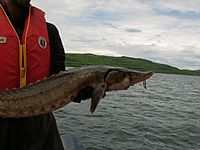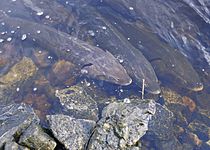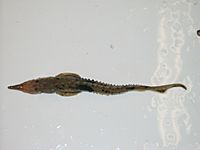Lake sturgeon facts for kids
Quick facts for kids Lake sturgeon |
|
|---|---|
 |
|
| A lake sturgeon | |
| Conservation status | |
| Scientific classification | |
| Synonyms | |
|
The lake sturgeon (Acipenser fulvescens), also known as the rock sturgeon, is a large North American freshwater fish. It is one of about 25 types of sturgeon found around the world. Like other sturgeons, it is an ancient fish that lives at the bottom of rivers and lakes.
The lake sturgeon has a skeleton partly made of cartilage (like your nose or ears). It has a streamlined body shape and rows of bony plates on its sides and back. The fish uses its long, shovel-like snout to dig into the mud and sand on the bottom of rivers and lakes while it looks for food. It also has four special feelers, called barbels, near its mouth. These barbels help the sturgeon find its prey on the bottom. Lake sturgeons can grow very large, sometimes over 7.25 ft (2.2 m) long and weighing more than 240 lb (108 kg).
Contents
About the Lake Sturgeon
The lake sturgeon has taste buds on its barbels and around its rubbery lips, which it can stretch out. It uses its lips to suck up soft live food. Since it does not have teeth, it swallows its food whole. Its diet mostly includes insect larvae, worms (like leeches), and other small creatures it finds in the mud. It rarely eats other fish, except possibly the invasive round goby. Because it is a large fish that eats very small creatures, its feeding habits are sometimes compared to large marine animals, like some whales, which filter-feed.
Where Lake Sturgeon Live
This fish lives in the Mississippi River basin, reaching south to Alabama and Mississippi. It is found in the Great Lakes and the Detroit River, extending east along the St. Lawrence River to where the fresh water ends. To the west, it reaches Lake Winnipeg and the North Saskatchewan and South Saskatchewan Rivers. In the north, it lives in the Hudson Bay Lowland. In the east, you can find it in Lake Champlain and some rivers in Vermont. This wide distribution makes sense because all these areas were connected by large lakes that formed when glaciers melted in North America after the last ice age.
These sturgeon often travel to find food, good places to lay eggs, or to respond to changes in seasons. Young sturgeon usually live in pools deeper than about 6 feet. Adult sturgeon typically live deep in large lakes. They usually stay close to good spawning (egg-laying) spots. The amount of food available also plays a big part in where they choose to live.
Lake Sturgeon Life Cycle
Lake sturgeon can live for a very long time. Males usually live for about 55 years, and females can live for 80 to 150 years! They grow quickly when they are young.
Early Life of Lake Sturgeon
Lake sturgeon eggs start out yellow and are attached to a fatty mass in the female. When the eggs are ready, they turn olive green, gray, or black. The eggs usually hatch after 8 to 14 days. Other fish and small creatures might eat some of the fertilized eggs on the spawning grounds.
When they hatch, the larvae (baby fish) are tiny, about 10 mm long. These larvae soon swim freely in the water, staying away from the surface and the bottom. They are also attracted to darkness, looking for rocky places to hide. About two weeks after hatching, they drift downstream with the current for several miles. Then, they settle down onto the river bottom.
As young sturgeon, all their adult body parts form, except for their reproductive organs. They are thought to eat small creatures that live on the bottom, just like adult sturgeon. In late summer, young sturgeon (about one year old) gather in large groups in shallow river mouths and bays. After a year, young sturgeon can be found in the same places as adults.
Reproduction
Male lake sturgeon usually become ready to reproduce between 8 and 12 years old, but it can take up to 22 years. Females become ready to reproduce later, from 14 to 33 years old, most often around 24 to 26 years of age. These sturgeon lay their eggs on clean, gravelly areas in rivers, usually from April to June. They prefer water temperatures between 55 and 64 degrees Fahrenheit (13 to 18 degrees Celsius).
Lake sturgeon reproduce by swimming in circles around each other and shaking. The male releases his sperm, and then the female lays her eggs. Males reproduce every 2 to 7 years, while females reproduce every 4 to 9 years. Only a small number (10 to 20 percent) of adult lake sturgeon are ready to reproduce in any given season. Lake sturgeon are polygamous, meaning one fish mates with many partners. This helps increase the variety in their genes.
Protecting Lake Sturgeon
These fish were once killed because they were seen as a nuisance, damaging fishing gear. But then, their meat and eggs became very valuable. Commercial fishermen started targeting them. Between 1879 and 1900, fishermen in the Great Lakes caught an average of 4 million pounds (1800 metric tons) of sturgeon each year.
Catching so many fish was not sustainable. On top of that, pollution and the building of dams and other flood control structures caused problems. Sturgeon return each spring to lay eggs in the same streams and rivers where they were born. But they found their pathways blocked and their spawning grounds destroyed by mud from farming and logging. In the 1900s, sturgeon catches dropped sharply. More rules were put in place, and many fisheries closed. Today, 19 out of the 20 states where this fish originally lived list it as either threatened or endangered.
The sturgeon was once a valuable food fish, and its eggs were used to make caviar. Its swim bladder was also used to make isinglass, a product used in things like clarifying beer. In 1860, sturgeon caught by accident were often just killed and thrown back into the lake, burned, fed to pigs, or used as fertilizer. They were even stacked up like firewood to fuel steamboats. Once people realized their value, they were caught using every method possible. Over 5 million pounds were taken from Lake Erie in just one year. The fishing industry for sturgeon collapsed by 1900, and the fish populations have never fully recovered. Like most sturgeons, the lake sturgeon is rare now and is protected in many areas.
Besides being overfished, lake sturgeon have also been harmed by pollution and the loss of their migration routes. They are easily affected by too much fishing because they reproduce very slowly. Most sturgeon caught before they are 20 years old have never had a chance to breed. Females only lay eggs once every four or five years. Catching breeding females specifically for their eggs also greatly harms the population size. Few sturgeon today live to the extreme old age or reach the large size that sturgeon often did in the past.
Restoration Efforts
In 2001, scientists placed transmitters on ten sturgeon and put egg mats in the Detroit River. This helped them find evidence of sturgeon laying eggs for the first time in many decades. This discovery came after finding spawning activity under the Blue Water Bridge in the St. Clair River in 2001.
The Little River Band of Ottawa Indians (LRBOI) in Michigan started their Sturgeon Program in 2001. In 2002, they successfully found natural reproduction of lake sturgeon by catching newly hatched fish (larvae) from the Big Manistee River. A special facility called the Streamside Rearing Facility for lake sturgeon on the Big Manistee River opened in 2004. This was the first time this method had been used for this type of fish. Since then, five similar facilities have been built in the Lake Michigan area, all based on the LRBOI design. Many groups now work together on this effort, including the U.S. Fish and Wildlife Service and the States of Michigan and Wisconsin. The LRBOI Nmé Stewardship Plan, created by biologists and Tribal members, was published in 2005 to guide the LRBOI sturgeon program and restoration efforts. New York State also has a successful recovery program. They use eggs and sperm collected from a spawning area on the St. Lawrence River. In June 2017, aquatic biologists helped with reproduction efforts, sending 130,000 fertilized eggs to hatcheries.
Several lake sturgeon populations have started to recover with help from the U.S. Fish and Wildlife Service (USFWS). There are fisheries from North Carolina to the Great Lakes that support restoring lake sturgeon populations. However, many lake sturgeon populations are still in danger. The USFWS is working to restore the species by tracking how many there are, where they live, their age, how they grow, and their health. Lake sturgeon are tagged and released by the USFWS to better understand their life cycle. Strict rules have been put in place to control fishing, and hatcheries are widely used in restoration efforts.
Recreational Fishing
Today, limited sturgeon fishing seasons are allowed in only a few places, including some areas in Minnesota, Wisconsin, and Michigan. For example, fishing for sturgeon is allowed on Black Lake in Michigan. However, only five fish can be caught each year. Each fish must be over 36 in (910 mm) long and caught through the ice with spears.
Anglers in Minnesota can catch one lake sturgeon per year between 45 and 50 in long on the Rainy River and Lake of the Woods (on the Canada–US border). The early season runs from April 24 to May 7 each year, and the late season runs from July 1 to September 30. Anglers must have a valid Minnesota fishing license and buy a sturgeon tag to keep a lake sturgeon.
An annual sturgeon spearing season is open on Lake Winnebago in Wisconsin. This season used to last 16 days, but now it has a set limit on how many fish can be caught. However, the season can still last the full 16 days. If 90–99% of the limit is reached on any day, the season ends at 1:00 pm the next day. If 100% or more of the limit is reached, the Wisconsin Department of Natural Resources can stop the season immediately. In 2012, the largest sturgeon ever caught on Lake Winnebago was a female that was 125 years old, weighed 240 lb, and measured 87.5 in long. Scientists from the Wisconsin Department of Natural Resources tagged and released her.
The sturgeon is also found in Quebec in the St. Lawrence River, where it is caught by commercial fishermen. It is also a game fish, with a limit of one per day for recreational anglers.
Wolf Lake State Fish Hatchery in Kalamazoo, Michigan, raises and releases lake sturgeon. These sturgeon are mainly released into inland waters, though some are stocked in the Great Lakes.
There is also a streamside rearing facility near Onaway, Michigan on the Black River. This river flows into the Cheboygan River, which then flows into Lake Huron. The facility is run by the Michigan Department of Natural Resources, Michigan State University, and Tower Kliber. Each year, hundreds to thousands of sturgeon are raised and released into Black Lake and other nearby areas. Adult sturgeon are caught in the river, and their eggs and sperm are collected. These are then taken back to the hatchery for fertilization and to hatch. Newly hatched larvae are also caught in the river using drift nets. The hatchery is open to the public, and people can watch the hatchery workers catch the fish.
Images for kids
See also
 In Spanish: Esturión de lago para niños
In Spanish: Esturión de lago para niños







